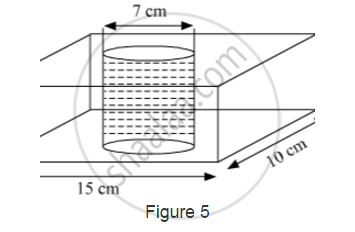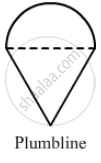Advertisements
Advertisements
प्रश्न
The radii of the circular bases of a frustum of a right circular cone are 12 cm and 3 cm and the height is 12 cm. Find the total surface area and the volume of the frustum.
उत्तर
The height of the frustum cone is h= 12 cm. The radii of the bottom and top circles are r1 = 12cm and r2 = 3cm respectively.
The slant height of the frustum cone is
`l=sqrt((r_1-r_2)^2+h^2`
`=sqrt((12-3)^2+12^2`
`=sqrt(225)`
= 15 cm
The total surface area of the frustum cone is
`=pi(r_1+r_2)xxl+pir_2^2+pir_2^2`
`=pixx(12+3)xx15+pixx12^2+pixx3^2`
= π x 225 x 26 + 144π + 9π
= 378π cm2
Hence Total surface area = 378π cm2
The volume of the frustum cone is
`V=1/3pi(r_1^2+r_1r_2+r_2^2)xxh`
`=1/3pi(12^2+12xx3+3^2)xx12`
`=1/3xxpixx189xx12`
= 756π cm3
Hence Volume of frustum = 756π cm3
APPEARS IN
संबंधित प्रश्न
A hemispherical bowl of internal diameter 36 cm contains liquid. This liquid is filled into 72 cylindrical bottles of diameter 6 cm. Find the height of each bottle, if 10% liquid is wasted in this transfer.
In Fig. 5, from a cuboidal solid metallic block, of dimensions 15cm ✕ 10cm ✕ 5cm, a cylindrical hole of diameter 7 cm is drilled out. Find the surface area of the remaining block [Use
`pi=22/7`]

Water in a canal, 5·4 m wide and 1·8 m deep, is flowing with a speed of 25 km/hour. How much area can it irrigate in 40 minutes, if 10 cm of standing water is required for irrigation?
If the radii of circular ends of a bucket 24cm high are 5cm and 15cm. find surface area of
bucket?
Two cubes each of volume 27 cm3 are joined end to end to form a solid. Find the surface area of the resulting cuboid.
The largest cone is curved out from one face of solid cube of side 21 cm. Find the volume of the remaining solid.
A solid is in the form of a cylinder with hemispherical ends. Total height of the solid is 19 cm and the diameter of the cylinder is 7 cm. Find the volume and total surface area of the solid.
Three metallic cubes whose edges are 3 cm, 4 cm and 5 cm, are melted and recast into a single large cube. Find the edge of the new cube formed.
A plumbline (sahul) is a combination of

The boilers are used in thermal power plants to store water and then used to produce steam. One such boiler consists of a cylindrical part in middle and two hemispherical parts at its both ends.
Length of the cylindrical part is 7 m and radius of cylindrical part is `7/2` m.
Find the total surface area and the volume of the boiler. Also, find the ratio of the volume of cylindrical part to the volume of one hemispherical part.

